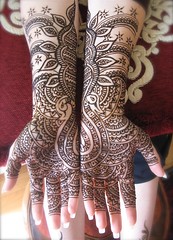
Henna, also known as Heena, is a form of body art that has existed since ancient times. Mehndi (or Henna) is the application of henna as a temporary form of skin decoration, in countries like Egypt, Iran, Pakistan, Syria, Morocco, Yemen, and Somaliland. It is typically employed for special occasions, particularly weddings. It is usually drawn on the hands and feet, where the color will be darkest.
The patterns of mehndi are typically quite intricate and predominantly applied to brides before wedding ceremonies. However, Mehndi decorations became fashionable in the West in the late 1990s, where they are sometimes called "henna tattoos".
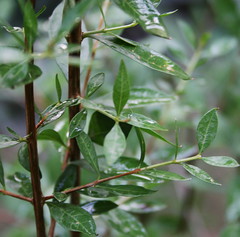
Henna is a flowering plant, the sole species in the genus Lawsonia in the family Lythraceae. It is native to tropical and subtropical regions of Africa, southern Asia, and northern Australasia in semi-arid zones. Henna is a tall shrub or small tree, 2–6 m high.

Henna, produces a red-orange dye molecule called lawsone. This molecule has an affinity for bonding with protein, and thus has been used to dye skin, hair, fingernails, leather, silk and wool. It is usually drawn on the hands and feet, where the color will be darkest because the skin contains higher levels of keratin which binds permanently to lawsone, the colorant of henna.
Mehndi (Henna) Art
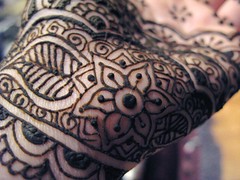
Henna has been used to adorn young women’s bodies as part of social and holiday celebrations since the late Bronze Age in the eastern Mediterranean. Henna was regarded as having “Barakah”, blessings, and was applied for luck as well as joy and beauty. Brides typically had the most henna, and the most complex patterns, to support their greatest joy, and wishes for luck. Some bridal traditions were very complex, such as those in Yemen, where the Jewish bridal henna process took four or five days to complete, with multiple applications and resist work.
Henna paste is usually applied to the skin using a plastic cone or a paint brush, but sometimes a small metal-tipped jacquard bottle used for silk painting (a jac bottle) is used. The cone has a fine opening at the thin end which lets a thin flow of paste to facilitate intricate designing.
Why is Henna as Body Art Popular?

Henna painting has become very popular as a form of temporary tattoo and is liked by a lot. The best aspect of henna is that it is totally natural, made from a plant plant whose leaves are first dried and then crushed to make a fine powder. While applying, the powder is mixed with water. This makes henna totally safe to use. Along with that, its application is totally painless and the effect is temporary. You can use henna to get tattoos, without worrying about pain or infection. In case you are not satisfied with a particular tattoo, just wait for a few days. Its color will soon wash off and you can easily go for another design.

 Henna, also known as Heena, is a form of body art that has existed since ancient times. Mehndi (or Henna) is the application of henna as a temporary form of skin decoration, in countries like Egypt, Iran, Pakistan, Syria, Morocco, Yemen, and Somaliland. It is typically employed for special occasions, particularly weddings. It is usually drawn on the hands and feet, where the color will be darkest.
Henna, also known as Heena, is a form of body art that has existed since ancient times. Mehndi (or Henna) is the application of henna as a temporary form of skin decoration, in countries like Egypt, Iran, Pakistan, Syria, Morocco, Yemen, and Somaliland. It is typically employed for special occasions, particularly weddings. It is usually drawn on the hands and feet, where the color will be darkest.










 Henna is a flowering plant, the sole species in the genus Lawsonia in the family Lythraceae. It is native to tropical and subtropical regions of Africa, southern Asia, and northern Australasia in semi-arid zones. Henna is a tall shrub or small tree, 2–6 m high.
Henna is a flowering plant, the sole species in the genus Lawsonia in the family Lythraceae. It is native to tropical and subtropical regions of Africa, southern Asia, and northern Australasia in semi-arid zones. Henna is a tall shrub or small tree, 2–6 m high. Henna, produces a red-orange dye molecule called lawsone. This molecule has an affinity for bonding with protein, and thus has been used to dye skin, hair, fingernails, leather, silk and wool. It is usually drawn on the hands and feet, where the color will be darkest because the skin contains higher levels of keratin which binds permanently to lawsone, the colorant of henna.
Henna, produces a red-orange dye molecule called lawsone. This molecule has an affinity for bonding with protein, and thus has been used to dye skin, hair, fingernails, leather, silk and wool. It is usually drawn on the hands and feet, where the color will be darkest because the skin contains higher levels of keratin which binds permanently to lawsone, the colorant of henna.  Henna has been used to adorn young women’s bodies as part of social and holiday celebrations since the late Bronze Age in the eastern Mediterranean. Henna was regarded as having “Barakah”, blessings, and was applied for luck as well as joy and beauty. Brides typically had the most henna, and the most complex patterns, to support their greatest joy, and wishes for luck. Some bridal traditions were very complex, such as those in Yemen, where the Jewish bridal henna process took four or five days to complete, with multiple applications and resist work.
Henna has been used to adorn young women’s bodies as part of social and holiday celebrations since the late Bronze Age in the eastern Mediterranean. Henna was regarded as having “Barakah”, blessings, and was applied for luck as well as joy and beauty. Brides typically had the most henna, and the most complex patterns, to support their greatest joy, and wishes for luck. Some bridal traditions were very complex, such as those in Yemen, where the Jewish bridal henna process took four or five days to complete, with multiple applications and resist work. Henna painting has become very popular as a form of temporary tattoo and is liked by a lot. The best aspect of henna is that it is totally natural, made from a plant plant whose leaves are first dried and then crushed to make a fine powder. While applying, the powder is mixed with water. This makes henna totally safe to use. Along with that, its application is totally painless and the effect is temporary. You can use henna to get tattoos, without worrying about pain or infection. In case you are not satisfied with a particular tattoo, just wait for a few days. Its color will soon wash off and you can easily go for another design.
Henna painting has become very popular as a form of temporary tattoo and is liked by a lot. The best aspect of henna is that it is totally natural, made from a plant plant whose leaves are first dried and then crushed to make a fine powder. While applying, the powder is mixed with water. This makes henna totally safe to use. Along with that, its application is totally painless and the effect is temporary. You can use henna to get tattoos, without worrying about pain or infection. In case you are not satisfied with a particular tattoo, just wait for a few days. Its color will soon wash off and you can easily go for another design. 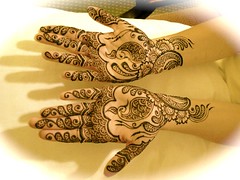 Though there are no set patterns or designs for Henna, there are some popular designs that have been followed since ages. One of the most popular designs is a paisley that is often filled with a checkerboard pattern. Another popular pattern is a lovely peacock, with the sharp and curved beak and the corona on the head. Floral patterns are quite popular as well.
Though there are no set patterns or designs for Henna, there are some popular designs that have been followed since ages. One of the most popular designs is a paisley that is often filled with a checkerboard pattern. Another popular pattern is a lovely peacock, with the sharp and curved beak and the corona on the head. Floral patterns are quite popular as well. 
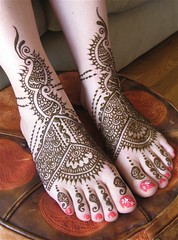
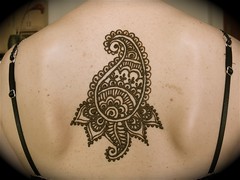
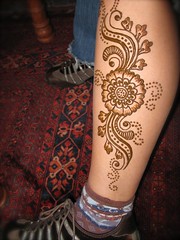
















No comments:
Post a Comment